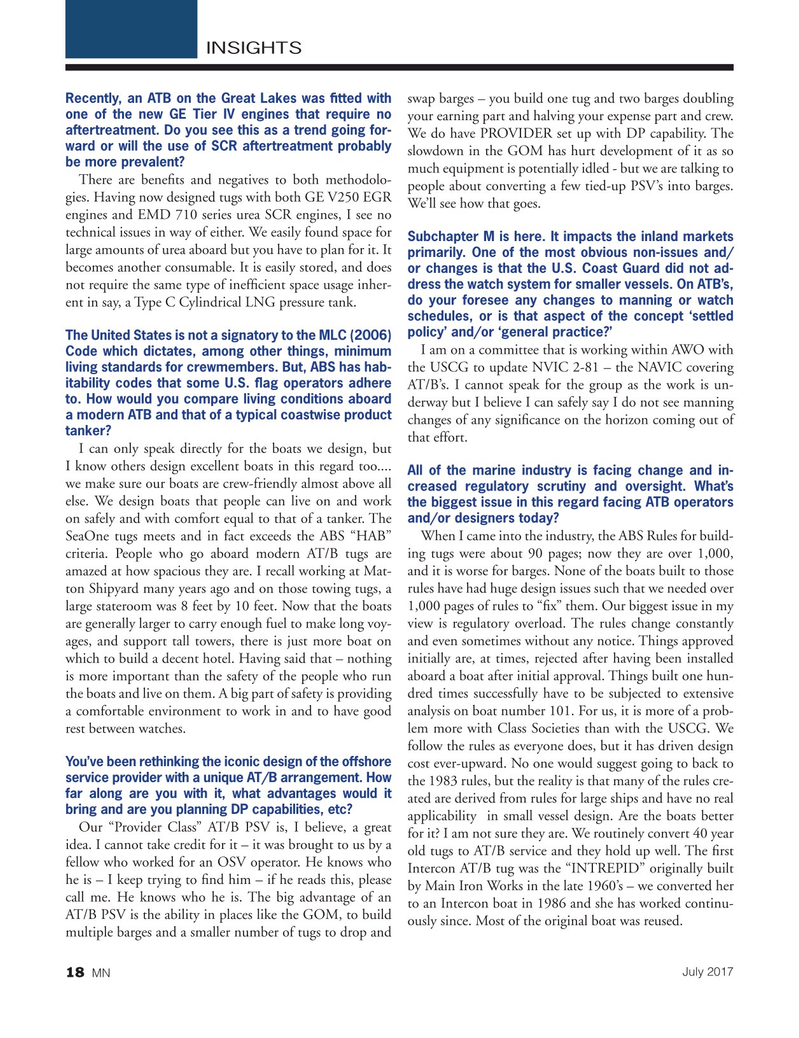
Page 18: of Marine News Magazine (July 2017)
Propulsion Technology
Read this page in Pdf, Flash or Html5 edition of July 2017 Marine News Magazine
INSIGHTS swap barges – you build one tug and two barges doubling
Recently, an ATB on the Great Lakes was ? tted with one of the new GE Tier IV engines that require no your earning part and halving your expense part and crew. aftertreatment. Do you see this as a trend going for-
We do have PROVIDER set up with DP capability. The ward or will the use of SCR aftertreatment probably slowdown in the GOM has hurt development of it as so be more prevalent? much equipment is potentially idled - but we are talking to
There are bene? ts and negatives to both methodolo- people about converting a few tied-up PSV’s into barges. gies. Having now designed tugs with both GE V250 EGR We’ll see how that goes.
engines and EMD 710 series urea SCR engines, I see no technical issues in way of either. We easily found space for
Subchapter M is here. It impacts the inland markets large amounts of urea aboard but you have to plan for it. It primarily. One of the most obvious non-issues and/ becomes another consumable. It is easily stored, and does or changes is that the U.S. Coast Guard did not ad- dress the watch system for smaller vessels. On ATB’s, not require the same type of inef? cient space usage inher- do your foresee any changes to manning or watch ent in say, a Type C Cylindrical LNG pressure tank.
schedules, or is that aspect of the concept ‘settled policy’ and/or ‘general practice?’
The United States is not a signatory to the MLC (2006)
I am on a committee that is working within AWO with
Code which dictates, among other things, minimum the USCG to update NVIC 2-81 – the NAVIC covering living standards for crewmembers. But, ABS has hab- itability codes that some U.S. ? ag operators adhere
AT/B’s. I cannot speak for the group as the work is un- to. How would you compare living conditions aboard derway but I believe I can safely say I do not see manning a modern ATB and that of a typical coastwise product changes of any signi? cance on the horizon coming out of tanker?
that effort.
I can only speak directly for the boats we design, but
I know others design excellent boats in this regard too....
All of the marine industry is facing change and in- we make sure our boats are crew-friendly almost above all creased regulatory scrutiny and oversight. What’s else. We design boats that people can live on and work the biggest issue in this regard facing ATB operators and/or designers today? on safely and with comfort equal to that of a tanker. The
SeaOne tugs meets and in fact exceeds the ABS “HAB” When I came into the industry, the ABS Rules for build- criteria. People who go aboard modern AT/B tugs are ing tugs were about 90 pages; now they are over 1,000, amazed at how spacious they are. I recall working at Mat- and it is worse for barges. None of the boats built to those ton Shipyard many years ago and on those towing tugs, a rules have had huge design issues such that we needed over large stateroom was 8 feet by 10 feet. Now that the boats 1,000 pages of rules to “? x” them. Our biggest issue in my are generally larger to carry enough fuel to make long voy- view is regulatory overload. The rules change constantly ages, and support tall towers, there is just more boat on and even sometimes without any notice. Things approved which to build a decent hotel. Having said that – nothing initially are, at times, rejected after having been installed is more important than the safety of the people who run aboard a boat after initial approval. Things built one hun- the boats and live on them. A big part of safety is providing dred times successfully have to be subjected to extensive a comfortable environment to work in and to have good analysis on boat number 101. For us, it is more of a prob- rest between watches. lem more with Class Societies than with the USCG. We follow the rules as everyone does, but it has driven design
You’ve been rethinking the iconic design of the offshore cost ever-upward. No one would suggest going to back to service provider with a unique AT/B arrangement. How the 1983 rules, but the reality is that many of the rules cre- far along are you with it, what advantages would it ated are derived from rules for large ships and have no real bring and are you planning DP capabilities, etc?
applicability in small vessel design. Are the boats better
Our “Provider Class” AT/B PSV is, I believe, a great for it? I am not sure they are. We routinely convert 40 year idea. I cannot take credit for it – it was brought to us by a old tugs to AT/B service and they hold up well. The ? rst fellow who worked for an OSV operator. He knows who Intercon AT/B tug was the “INTREPID” originally built he is – I keep trying to ? nd him – if he reads this, please by Main Iron Works in the late 1960’s – we converted her call me. He knows who he is. The big advantage of an to an Intercon boat in 1986 and she has worked continu-
AT/B PSV is the ability in places like the GOM, to build ously since. Most of the original boat was reused.
multiple barges and a smaller number of tugs to drop and
July 2017 18 MN

 17
17

 19
19
